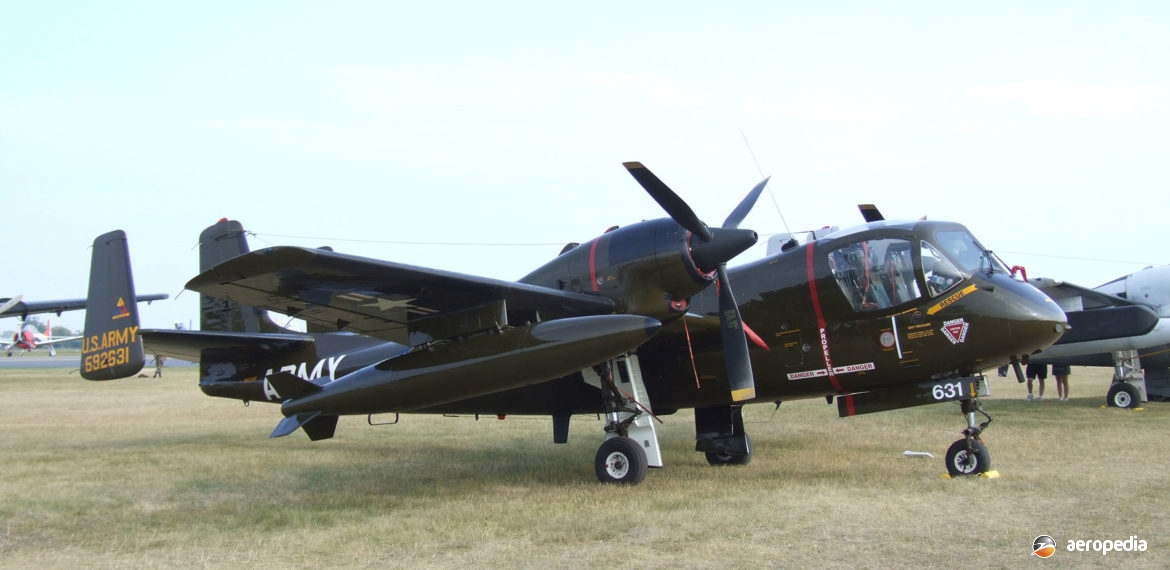Photograph:
Grumman OV-1 Mohawk N631JF at Oshkosh, Wisconsin, in July 2007 (David C Eyre)
Country of origin:
United States of America
Description:
Combat surveillance aircraft
Power Plant:
Two 858 kw (1,150 shp) Lycoming T53-L-7 turboprops
Specifications:
- Wingspan: 12.8 m (42 ft)
- Length: 12.5 m (41 ft)
- Height: 3.86 m (12 ft 8 in)
- Wing area: 30.65 m² (330 sq ft)
- Max speed at 1,520 m (5,000 ft): 496 km/h (308 mph)
- Max diving speed: 724 km/h (450 mph)
- Max cruising speed: 478 km/h (297 mph)
- Economical cruising speed: 423 km/h (263 mph)
- Stalling speed: 116 km/h (72 mph)
- Initial rate of climb: 814 m/min (2,670 ft/min)
- Service ceiling: 9,150 m (30,000 ft)
- Range on internal fuel at 1,520 m (5,000 ft) at 370 km/h (230 mph): 710 km (441 miles)
- Max range with two 568 litre (125 Imp gal) drop tanks: 2,140 km (1,330 miles)
- Empty weight: 4,704 kg (10,370 lb)
- Loaded weight (clean): 5,915 kg (13,040 lb)
- Max loaded weight: 6,985 kg (15,399 lb)
Armament:
None (see text)
History:
The Grumman OV-1 Mohawk was developed for the United States Army for the observation role, affording exceptional visibility to the two man crew and able to carry a variety of cameras, radar and infra-red detection systems for photo reconnaissance and electronic surveillance. The prototype, known initially as the YAO-1AF and later the YOV-1A, made its first flight in April 1959, the initial production model, the OV-1A, being delivered to service from February 1960. Nine YOV-1A (serials 57-6463 to 57-6467 and 57-6538 to 57-6541) aircraft were involved in the evaluation program.
The crew was protected by aluminium alloy floor plate, removable flak curtains and a bullet resistant windshield, the armour weighing 111.5 kg (246 lb). Martin-Baker ground-level ejector seats were installed, and dual controls were provided. The structure of the aircraft was rugged and it was able to operate from short, rough airstrips. Power plant was the Lycoming T53-L-7 turboprop which provided 716 kw (960 shp) and 34 kw (45 ehp) residual thrust driving 3.048 m (10 ft) diameter Hamilton Standard 53C51 hydromatic fully-feathering reversible-pitch propellers.
The OV-1A was followed into production by the OV-1B, which had increased capability due to having an APS-94 SLAR (side-looking) radar housed in a fairing under the fuselage. The OV-1C was equipped with the UAS-4 infra-red ground surveillance system.
Initial order was for 18 OV-1As (59-2603 to 59-2620) and 17 OV-1Bs (59-2621 to 59-2637). Later further OV-1As were built (60-3720 to 60-3744) and OV-1Cs (60-3745 to 60-3761), a total of 77 aircraft. Further contracts were placed and by late 1963 some 152 aircraft had been delivered. The OV-1B had the wingspan increased to 14.63 m (48 ft) from the 12.8 m (42 ft) of the OV-1A and OV-1Cs. In 1967 Grumman converted four OV-1Cs to OV-1D prototypes with the Lycoming T53-L-701 engine with updated cameras, side-looking radar and infra-red detection equipment. Some 37 were delivered.
The Mohawk entered US Army service in 1961 in Germany with the 7th Army at Sandhofen near Mannheim but in July 1962 aircraft were taken to Vietnam to serve with the 23rd Special Warfare Aviation Detachment. In 1964 the US Army put into operational use the JOV-1A with the 11th Air Assault Division of the 1st Cavalry Division. This model carried a range of 70 mm (2.75 in) rocket pods and 12.7 mm (0.5 in) machine gun pods on pylons under the wings. These aircraft operated with this unit until the following year when they were taken over by the 23rd Aerial Surveillance Company.
Eventually the OV-1C received a modification program which, amongst other things, included the replacement of the T53-L-3 turboprops with the up-rated L-7 engine, the deactivation of the wing leading-edge slats and the fitting of new navigation equipment including Doppler. The type was used extensively against the North Vietnamese and Viet Cong over the battlefields of South Vietnam and Laos.
One variant was fitted with side-looking radar (SLAR) which meant the crew was able to look through foliage and map terrain, providing a film image of the earth. These were used in the 1960s to patrol the demilitarised zone in Korea. In US Army service cargo pods were developed which could be fitted to underwing hard points to assist in the re-supply of troops.
In 2011 Alliant Techsystems, with its partners, submitted a modernised variant of the OV-1D for use as a counter insurgency aircraft, a demonstrator being built fitted with an FLIR Star Safire turret and a ventral M-230 chain gun, this aircraft becoming known as the OV-1E. Two variants were also built for electronic intelligence gathering duties, becoming known as the RV-1C and RV-1D. Examples have also been operated by the Argentine and Israeli Air Forces.
It is not believed a US Army Mohawk ever visited this part of the world. However, the forward fuselage section and cockpit of an ex-US Army Mohawk, along with fuselage sections of a Martin B-57 Canberra and a North American F-86 Sabre, have been imported by Mr R Winterburn and placed on display in his museum at Arnold near Bendigo, VIC. A number of complete Mohawks have survived at museums in the United States and a couple has been restored to airworthiness, particularly by the American Wings Air Museum in Minnesota.

